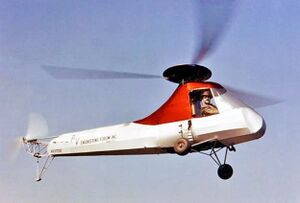Engineering:Piasecki PV-2
From HandWiki
Short description: US helicopter prototype
| PV-2 | |
|---|---|

| |
| PV-2 in flight testing | |
| Role | Helicopter |
| Manufacturer | P-V Engineering Forum |
| Designer | Frank Piasecki |
| First flight | April 11, 1943 |
| Produced | 1943 |
| Number built | 1 |
The Piasecki PV-2 was a helicopter designed by Frank Piasecki. The PV-2 is best known for being one of the first successful helicopters flown in the United States. The PV-2 first flew on April 11, 1943.[1] Developed as a technology demonstrator, the PV-2 brought several new features such as the first dynamically balanced rotor blades, a rigid tail rotor with a tension-torsion pitch change system, and a full cyclic and collective rotor pitch control.[2]
The PV-2 is now on display at the National Air and Space Museum's Steven F. Udvar-Hazy Center
Specifications
Data from History - single rotor helicopters: PV-2[2]
General characteristics
- Crew: 1
- Capacity: 2
- Length: 21 ft 6 in (6.55 m) fuselage
- Max takeoff weight: 1,000 lb (454 kg)
- Powerplant: 1 × Franklin 4AC-199 4-cylinder horizontally-opposed piston engine, 90 hp (67 kW) at 2,500 rpm[3]
- Main rotor diameter: 24 ft 11 in (7.6 m)
- Main rotor area: 488.4 sq ft (45.37 m2)
- Blade section: NACA 0012[4]
Performance
- Maximum speed: 100 mph (160 km/h, 87 kn)
- Range: 150 mi (240 km, 130 nmi)
References
- ↑ National Aviation Hall of Fame - Frank Piasecki
- ↑ 2.0 2.1 "History - single rotor helicopters: PV-2". 2001. http://www.piasecki.com/pv-21.htm.
- ↑ Erickson, Jack (1 November 2016). "Franklin1". Aircraft Engine Historical Society. http://www.enginehistory.org/Piston/HOAE/Franklin1.html. Retrieved 21 January 2020.
- ↑ Lednicer, David. "The Incomplete Guide to Airfoil Usage". https://m-selig.ae.illinois.edu/ads/aircraft.html. Retrieved 16 April 2019.
External links
- P-V Engineering Forum PV-2 at the National Air and Space Museum
- Popular Science August 1951, page 30 rare photo of PV-2 in flight
Template:Piasecki/Vertol aircraft
 |

